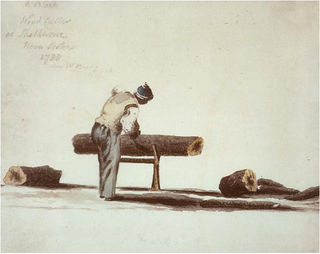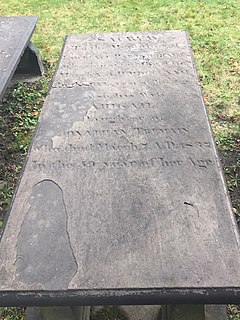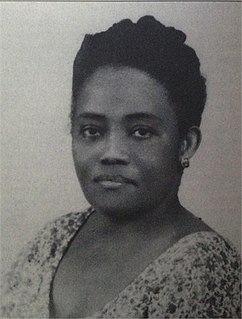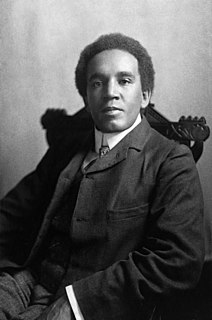Related Research Articles

Black Loyalists were people of African descent who sided with the Loyalists during the American Revolutionary War. In particular, the term refers to men who escaped enslavement by Patriot masters and served on the Loyalist side because of the Crown's guarantee of freedom.
The Sierra Leone Company was the corporate body involved in founding the second British colony in Africa on 11 March 1792 through the resettlement of Black Loyalists who had initially been settled in Nova Scotia after the American Revolutionary War. The company came about because of the work of the ardent abolitionists, Granville Sharp, Thomas Clarkson, Henry Thornton, and Thomas's brother, John Clarkson, who is considered one of the founding fathers of Sierra Leone. The company was the successor to the St. George Bay Company, a corporate body established in 1790 that re-established Granville Town in 1791 for the 60 remaining Old Settlers.
Thomas Peters, born Thomas Potters, was a veteran of the Black Pioneers, fighting for the British in the American Revolutionary War. A Black Loyalist, he was resettled in Nova Scotia, where he became a politician and one of the "Founding Fathers" of the nation of Sierra Leone in West Africa. Peters was among a group of influential Black Canadians who pressed the Crown to fulfill its commitment for land grants in Nova Scotia. Later they recruited African-American settlers in Nova Scotia for the colonisation of Sierra Leone in the late eighteenth century.

Lieutenant John Clarkson was a Royal Navy officer and abolitionist, the younger brother of Thomas Clarkson, one of the central figures in the abolition of slavery in England and the British Empire at the close of the 18th century. As agent for the Sierra Leone Company, Lieutenant Clarkson was instrumental in the founding of Freetown, today Sierra Leone's capital city, as a haven for chiefly formerly enslaved African-Americans first relocated to Nova Scotia by the British military authorities following the American Revolutionary War.

Black Nova Scotians or African Nova Scotians are Black Canadians whose ancestors primarily date back to the Colonial United States as enslaved people or freemen, and later arrived in Nova Scotia, Canada during the 18th and early 19th centuries. As of the 2016 Census of Canada, 21,915 Black people live in Nova Scotia, most in Halifax. Since the 1950s, numerous Black Nova Scotians have migrated to Toronto for its larger range of opportunities. Before the immigration reforms of 1967, Black Nova Scotians formed 37% of the total Black Canadian population.
Boston King was a former American slave and Black Loyalist, who gained freedom from the British and settled in Nova Scotia after the American Revolutionary War. He later immigrated to Sierra Leone, where he helped found Freetown and became the first Methodist missionary to African indigenous people.
Harry Washington was a Black Loyalist in the American Revolutionary War, and enslaved by Virginia planter George Washington, later the first President of the United States. When the war was lost the British then evacuated him to Nova Scotia. In 1792 he joined nearly 1,200 freedmen for resettlement in Sierra Leone, where they set up a colony of free people of color.

The Book of Negroes is a document created by Brigadier General Samuel Birch, under the direction of Sir Guy Carleton, that records names and descriptions of 3,000 Black Loyalists, enslaved Africans who escaped to the British lines during the American Revolution and were evacuated to points in Nova Scotia as free people of colour.
Edward Jones (1807–1865) was an African American missionary to the colony of Sierra Leone. Jones was a prominent missionary and figure in the colony of Sierra Leone; he was the first naturalized citizen of Sierra Leone. Jones was the first black principal of Fourah Bay College. He was the first Black American to graduate from Amherst College in Massachusetts. Edward Jones was the brother of Jehu Jones, a prominent African-American preacher.
Settler Town is the oldest part of the city of Freetown, now the capital of Sierra Leone, and was the first home of the Nova Scotian Settlers.
The Jamaican Maroons in Sierra Leone were a group of just under 600 Jamaican Maroons from Cudjoe's Town, the largest of the five maroon towns in Jamaica, who were deported by British forces following the Second Maroon War in 1796, first to Nova Scotia. Four years later in 1800, they were transported to Sierra Leone.
Moses "Daddy" Wilkinson or "Old Moses" was known as a Black Loyalist who gained freedom from slavery in Virginia during the American Revolutionary War, was a Wesleyan Methodist preacher in New York and Nova Scotia, and migrated in 1791 to Sierra Leone. There he established the first Methodist church in Settler Town and survived a rebellion in 1800.
Cato Perkins was an African-American slave from Charleston, South Carolina who became a missionary to Sierra Leone.

Birchtown is a community and National Historic Site in the Canadian province of Nova Scotia, located near Shelburne in the Municipal District of Shelburne County. Founded in 1783, the village was the largest settlement of Black Loyalists and the largest free settlement of ethnic Africans in North America in the eighteenth century. The two other significant Black Loyalist communities established in Nova Scotia were Brindley town and Tracadie. Birchtown was named after British Brigadier General Samuel Birch, an official who helped lead the evacuation of Black Loyalists from New York.
Rawdon Street Methodist Church is a Methodist historical church in what was the historical Settler Town, Sierra Leone which is now known as Freetown, Sierra Leone. Rawdon Methodist was established by African American settlers in Sierra Leone who are known in Freetown as the 'Nova Scotian Settlers'. The first minister at the church was Joseph Brown; George Carrol (Carral) and Isom Gordon assisted him with running the church. Rawdon was supported built and supported by the Nova Scotians.

The Nova Scotian Settlers, or Sierra Leone Settlers were African-Americans who founded the settlement of Freetown, Sierra Leone and the Colony of Sierra Leone, on March 11, 1792. The majority of these black American immigrants were among 3000 African-Americans, mostly former slaves, who had sought freedom and refuge with the British during the American Revolutionary War, leaving rebel masters. They became known as the Black Loyalists. The Nova Scotian settlers were jointly led by African-American Thomas Peters, a former soldier, and English abolitionist John Clarkson. For most of the 19th century, the Settlers resided in Settler Town and remained a distinct ethnic group within the Freetown territory, tending to marry among themselves and with Europeans in the colony. Indigenous tribes in the region included the Sherbro and Mende.

Edna Elliott-Horton was the second West African woman from a British colony to receive a university degree after the Nigerian physician Agnes Yewande Savage, who received a medical degree from the University of Edinburgh in 1929. A Sierra Leonean, Elliott-Horton became the first West African woman to complete a BA degree in the liberal arts, after graduating from Howard University in 1933, where Dr. Edward Mayfield Boyle, her maternal uncle, had graduated as a medical doctor. Elliott-Horton was a political activist who challenged the colonial authorities in Sierra Leone through her participation in the West African Youth League which was formally established in her living-room.
William Gwinn was an African American from Boston, Massachusetts. He was one of the first black Americans to participate in the antebellum American Back-to-Africa movement under the auspices of Captain Paul Cuffe's 1815 voyage to Sierra Leone.

The Sierra Leone Creole people are an ethnic group of Sierra Leone. The Sierra Leone Creole people are descendants of freed African American, Afro-Caribbean, and Liberated African slaves who settled in the Western Area of Sierra Leone between 1787 and about 1885. The colony was established by the British, supported by abolitionists, under the Sierra Leone Company as a place for freedmen. The settlers called their new settlement Freetown. Today, the Sierra Leone Creoles are 1.3% of the population of Sierra Leone.
Charles Frederic Wenzel (1769–18??) was a German Lutheran missionary who worked in Sierra Leone. He worked under the auspices of the Anglican Church Missionary Society (CMS).
References
- 1 2 3 Fyfe C. (1991) Our Children Free and Happy: Letters from Black Settlers in Africa in the 1790s, edinburgh: Edinburgh University Press
- ↑ Clifford, Mary Louise (2006). From Slavery to Freetown: Black Loyalists After the American Revolution. Jefferson, North Carolina: McFarland and Co. p. 202.
- ↑ Gibson Wilson, Ellen (1980). John Clarkson and the African Adventure. London: Macmillan Press.